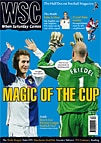 A season in which northern clubs made a revival saw Aston Villa move into the third tier, by Keith Wilson
A season in which northern clubs made a revival saw Aston Villa move into the third tier, by Keith Wilson
The long-term significance
The promotion of Blackpool and Huddersfield represented a brief revival for traditional northern clubs – against a prevailing trend. At the start of the 1960s Blackpool had been one of five Lancashire town teams in the First Division. By the end of that decade, with the abolition of the maximum wage badly affecting many smaller clubs, only Burnley were left – and they were to be relegated with Blackpool in 1970-71 (to return briefly in the mid‑1970s). Huddersfield, who had spent several seasons more at the top level than their west Yorkshire rivals Leeds, returned to Division Two after two seasons. Like Blackpool, they have spent much of the past 38 years in the bottom two divisions.
Story of the season
With Frank Worthington coming to national prominence for the first time, Huddersfield arrived in the top two with a 3-2 win at Hull in October and stayed put. The team also boasted a mean defence featuring future Leeds and England full‑back Trevor Cherry. Sheffield United, guided from midfield by another rising star, Tony Currie, looked likely to go up, too, until a run of four defeats in March took them from second to seventh. Blackpool only moved into a promotion spot in the final month; a goalless draw at rivals Leicester in late March proved to be decisive for both teams. It was an immediate success for Les Shannon, who had taken over in April 1969, but he left two months into the following season after his team lost a three-goal lead in a 4-3 defeat to Chelsea.
Newly promoted Swindon climbed steadily up to third, before falling away. Nevertheless, they went on to win the inaugural Anglo-Italian Cup – for which they had qualified as League Cup holders – with a 3-0 victory at Napoli that ended ten minutes early due to home fans rioting.
Preston and Villa were relegated to the Third Division for the first time. The latter had struggled ever since their relegation from Division One in 1966-67 – this time they were in the bottom two for almost the entire season, although a win in their final match left Charlton needing a point from their last game, a day later at home to Bristol City. Charlton won 2-1 and could be thankful that the League’s AGM had rejected a move to a three up, three down system, which was finally introduced in 1973-74.
Despite a 4-1 win over champions Huddersfield, a general lack of goals was Villa’s main problem – they failed to score in 20 of their 42 games. Manager Tommy Docherty was sacked in January 1970; his replacement, Vic Crowe, was to take Villa to a League Cup final in 1971.
For the record books
Despite their relegation, Villa were the best-supported club with an average attendance of 27,345, which was even an increase on the previous year. Conversely, a crowd of just under 7,000 watched the season’s most eventful game, Bolton’s 6-4 win over Queens Park Rangers, in which eight different players scored. John Hickton of Middlesbrough was the top scorer with 23 goals, two ahead of QPR’s Barry Bridges.
Same place today
Eleven of these clubs are in the Championship this season, including Cardiff, Preston and Hull, who are the only three not to have played at the top level for at least one season since.
Moved furthest away
After several fluctuations, Oxford United are now outside the League. Carlisle have also spent time in the Conference, while nine other clubs have been in the bottom division. Seven now play in different stadiums, not including Charlton, who spent a decade away from The Valley before returning in 1992.
From WSC 252 February 2008